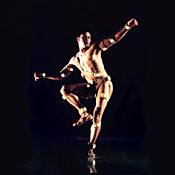
Every so often, Eliot Feld choreographs a piece to display the beauties of a particular dancer in his company, Ballet Tech. Behold the Man, given its premiere during the troupe’s spring season at the Joyce, is an homage to Nickemil Concepcion, who is fully worthy of such attention. The extended solo constituting the first half of the piece shows off a soulful face that Manuel Álvarez Bravo might have photographed and a thickset boxer’s body that adds luscious weight – rare in the realm of classical ballet – to the dancer’s soft, fluid way of moving. In this solo, Concepcion conveys pure physical sensation – which remains strangely voluptuous despite the fact that as the dance progresses, his body appears to be increasingly inflicted with pain – and the impression of thought and feeling in response to these circumstances. All this is accomplished, mind you, without the dancer’s resorting to anything that might be called acting.
Unfortunately, the choreography, set to austerely ominous music by David Lang and Brian Eno, depends on gadgetry. Concepcion appears nearly nude, outfitted only in webbing that’s studded with lights the size of Ping-Pong balls. Midway through the piece, he’s attached to a wrist harness, swung at a tilt through the darkened air, then whirled so swiftly that the lights form streaking paths like those of Saturn’s rings. The title of the dance is, of course, a translation of ecce homo, the term used to refer to a depiction of Christ crowned with thorns. For thorns, Feld substitutes a headdress of the garishly colored tube balloons twisted to form animal shapes for children at street fairs and birthday parties. The headdress is created onstage; the balloons are even blown up onstage (by a stagehand in overalls). Concepcion submits to these prolonged, idiotic proceedings with a dignity and courage not out of keeping with the character he’s playing. Finally, he’s allowed to run free, the balloons streaming behind him, and he’s such a compelling performer that you’re almost persuaded to accept the image as a kind of apotheosis.
Another novelty, Lincoln Portrait, looks to be Feld’s response to September 11 – part of the general public response that has Old Glory flying everywhere. More pageant than dance, it’s a solemn promenade of “ordinary” people – nondancers, that is, representing disparate ages, ethnicities, and body types – to Aaron Copland’s Fanfare for the Common Man and Lincoln Portrait, both composed following America’s entry into the Second World War. The latter score incorporates a text drawn from Lincoln’s morally resonant, plainspoken words, and these are delivered by an actor (Sam Waterston and Carmen De Lavallade alternated in the task).
A bevy of leotarded dancers invades the pedestrian crowd from time to time, performing what looks like a mid-century modern-dance exercise in ecstasy; inevitably, one of them bears a flag that ripples excitedly behind her as she leaps through the space. Any cross section of humanity is visually compelling, so the members of the onstage public are swell to look at, though their being dressed up to indicate different eras and occupations is a bit hokey. Lincoln Portrait can’t lay claim to the innocence of a real school pageant, but it does, intentionally or not, co-opt some of the real deal’s disarming naïveté.
Two other pieces introduced this season, Skandia and Pianola, proved to be examples of Feld’s all too familiar resorting to dubious evocations of local color and vehement but pointless reiterative jiggling, respectively. The Conlon Nancarrow music for player piano used for Pianola was at least a bracing element. More significant than the season’s new entries were the revivals of two ballets from his earliest (and, alas, most fertile) days – At Midnight, created in 1967, and the 1971 Theatre. Both are rich works – original, intelligent, and full of feeling – that promised a distinguished future for their choreographer. Some 30 years after their making, we have seen this undeniable talent continually dissipated in pieces that are childish, gimmicky, and obsessive. What happened?
Ballet Tech
Various works choreographed by Eliot Feld; at the Joyce Theater.